Vidhara /Argyreia nervosa (Burm. f.) / Argyreia speciosa Sweet./ Elephant creeper – Ayurvedic Uses, Benefits, Dosage & Therapeutic Actions
Abstract
Argyreia nervosa is commonly known as Hawaiian Baby Woodrose, Elephant Creeper, or Vridhadaraka, and it is a large perennial climbing vine belonging to the family Convolvulaceae. It is a highly valued medicinal plant in the Ayurvedic system of medicine. In Ayurveda, Vidhara (Argyreia nervosa) is renowned for its Rasayana (rejuvenating), Balya (strength-promoting), and Vajikarana (aphrodisiac) properties. It is particularly beneficial in managing Vata-related disorders such as paralysis, arthritis, muscular weakness, and neurological ailments. It has been extensively documented in various Ayurvedic Nighantus, including Dhanvantari Nighantu, Madanpala Nighantu, Kaiyadeva Nighantu, Raj Nighantu, Bhavaprakash Nighantu, and Adarsha Nighantu, among others.
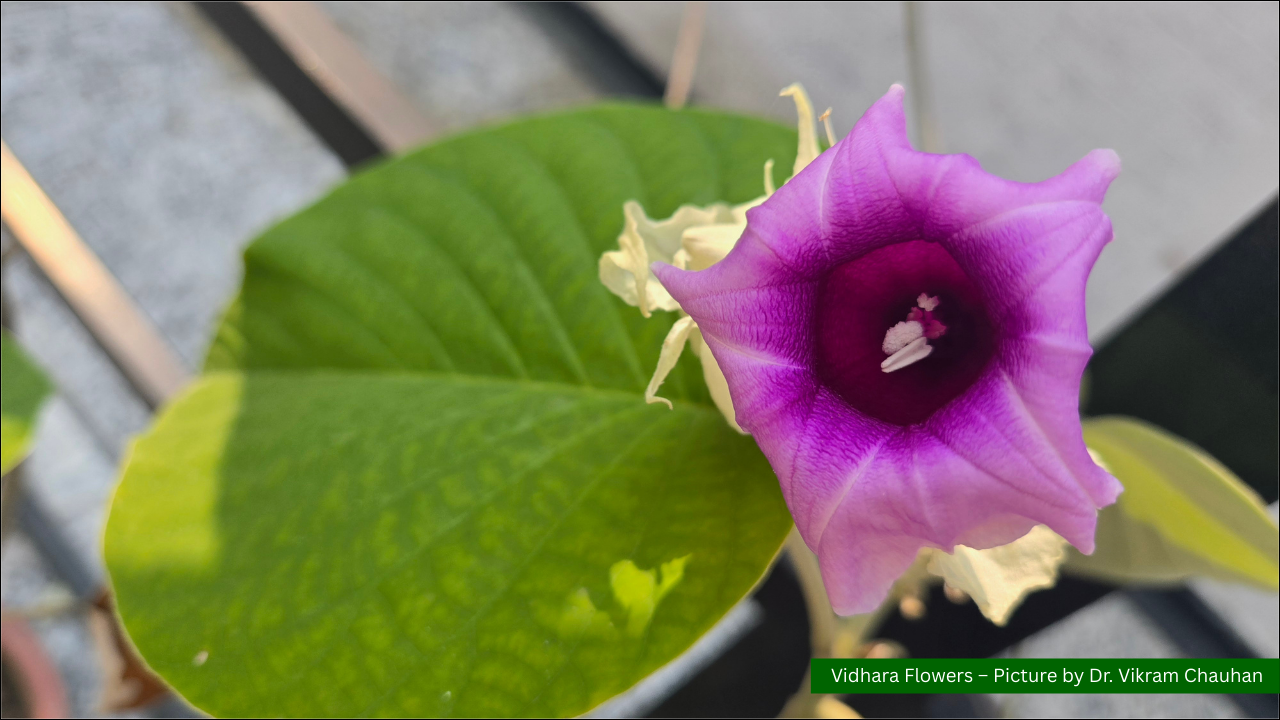
Introduction
Vidhara, botanically known as Argyreia nervosa or Argyreia speciosa, is a perennial climbing herb. It is also cultivated as an ornamental climber due to its large, heart-shaped foliage and attractive trumpet-shaped flowers. Vidhara is considered a controversial or doubtful drug in Ayurveda. Some scholars identify Ghavapatta as Vidhara. According to some scholars, Ipomoea petaloidea Chois., or at least a species from the same botanical family, may be the true Vidhara. The plant sold as Vidhara in the Varanasi region is likely this species. Dr Desai has considered the root of Ipomoea biloba Forsk. as Vriddhadaraka (another name for Vidhara). In the commentary of Ashtanga Sangraha, the description of this plant has also been provided, which is as follows:
त्रिकोणाकाण्डा सुबहुप्रताना फलेषु पीता कुसुमेषु रक्ता ।
पत्रैः सदुग्धैः मृदुरोमवद्भिस्ताम्बूलतुल्यैर्घनमूलकन्दैः ।।
According to the above shloka, Vidhara undoubtedly belongs to the Convolvulaceae family of climbing plants.
Scientific Classification
- Kingdom: Plantae
- Subkingdom: Tracheobionta
- Superdivision: Spermatophyta
- Division: Magnoliophyta
- Class: Magnoliopsida
- Subclass: Asteridae
- Order: Solanales
- Family: Convolvulaceae
- Genus: Argyreia Lour.
- Species: nervosa (Burm. f.) Bojer, speciosa Sweet.
Synonyms
- Trikonakanda – Stem is triangular in shape
- Hasthi Valli – Large leaves resembling the ear/palm of an elephant
- Samudra Patra – Leaves appear like sea foam from a distance
- Ajaantri
- Mahashyama
- Vallari / Vellari – Refers to a twining climber
- Deergha / Deerghavalaka – Indicates long or elongated structures
- Samudra Palaka / Samudra-patra – Associated with the sea-like whitish foliage beneath
- Avegi / Abegi (regional variation)
- Jongaka
- Jirnavalaka / Jeernadaru – Suggesting an aged or strong woody part
- Antakotarapushpi – Flower having a hollow throat

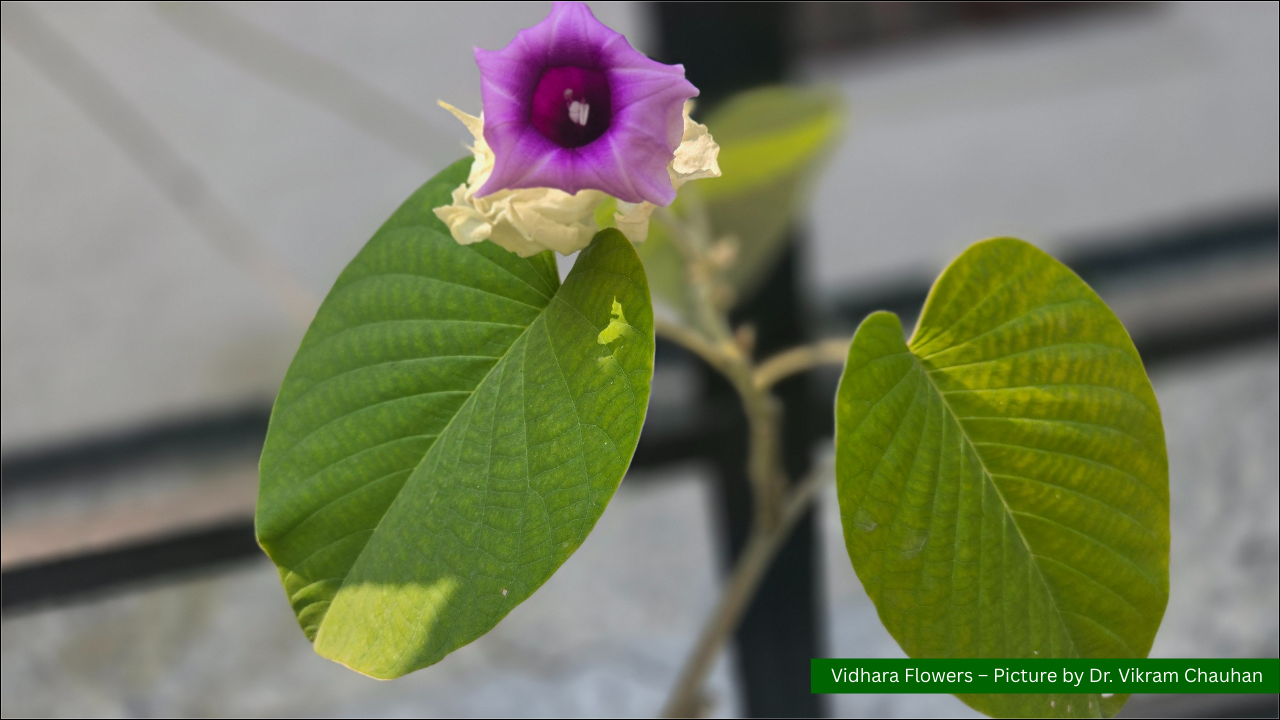
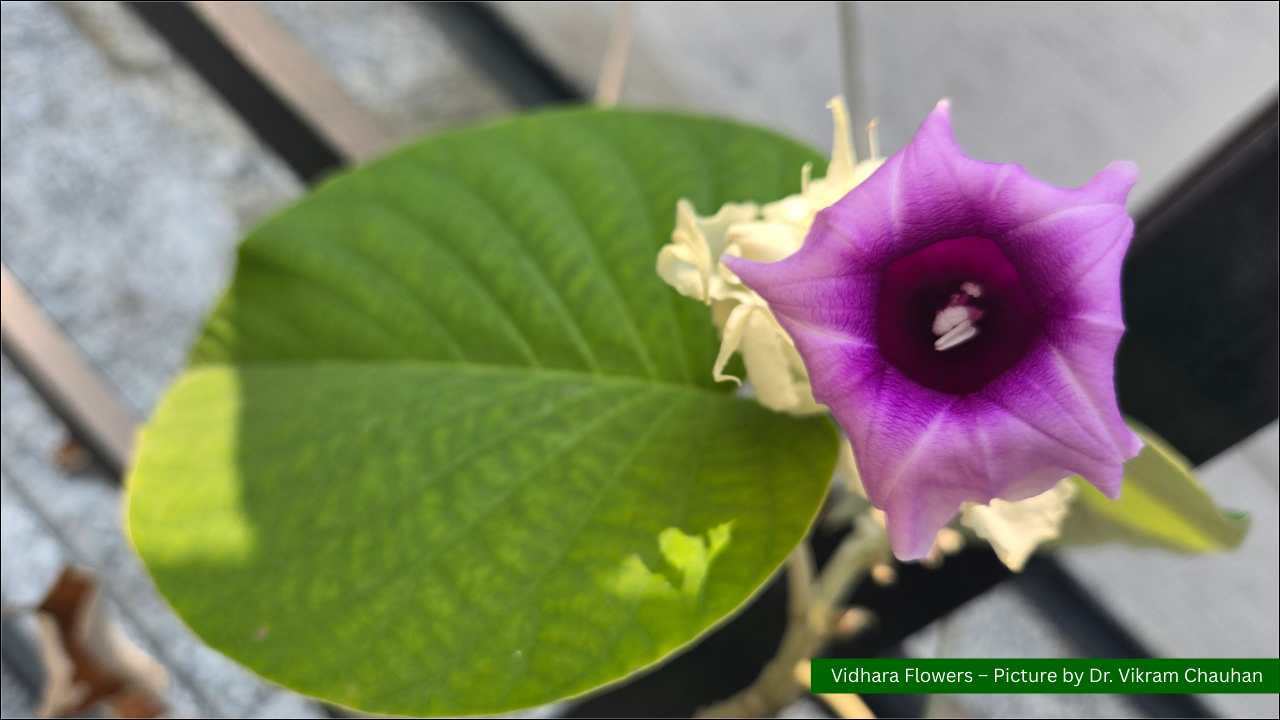
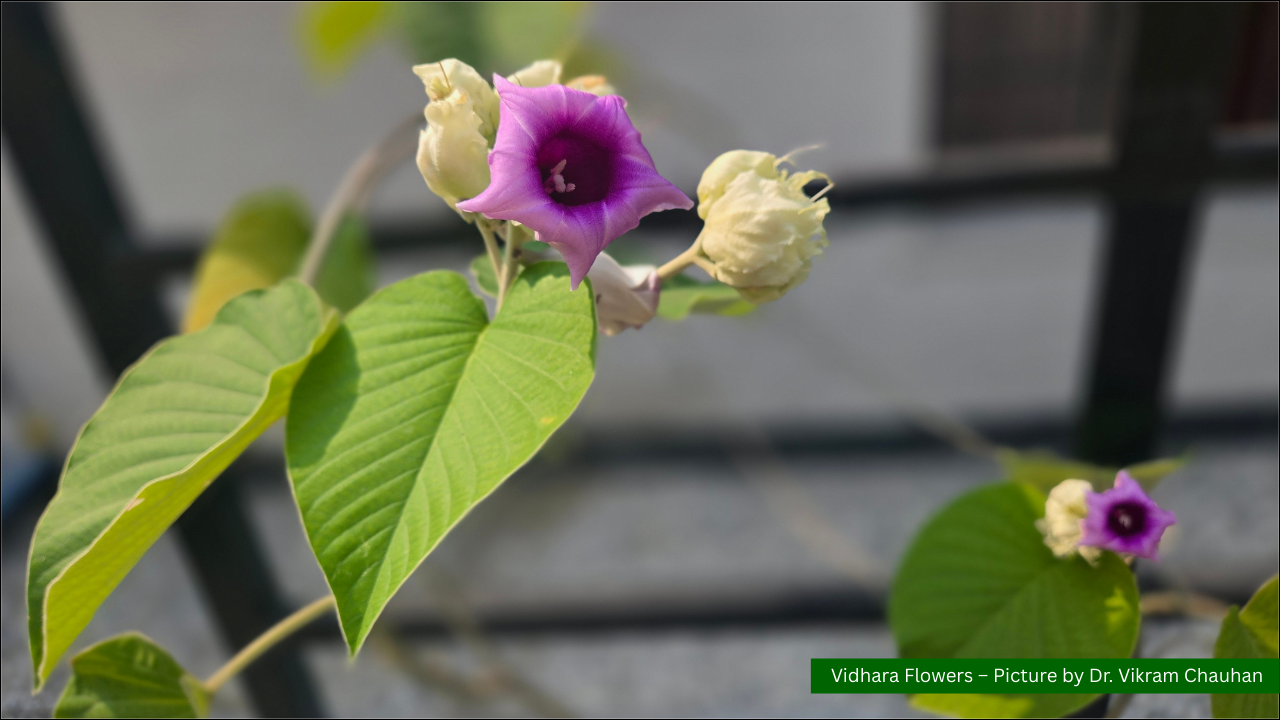
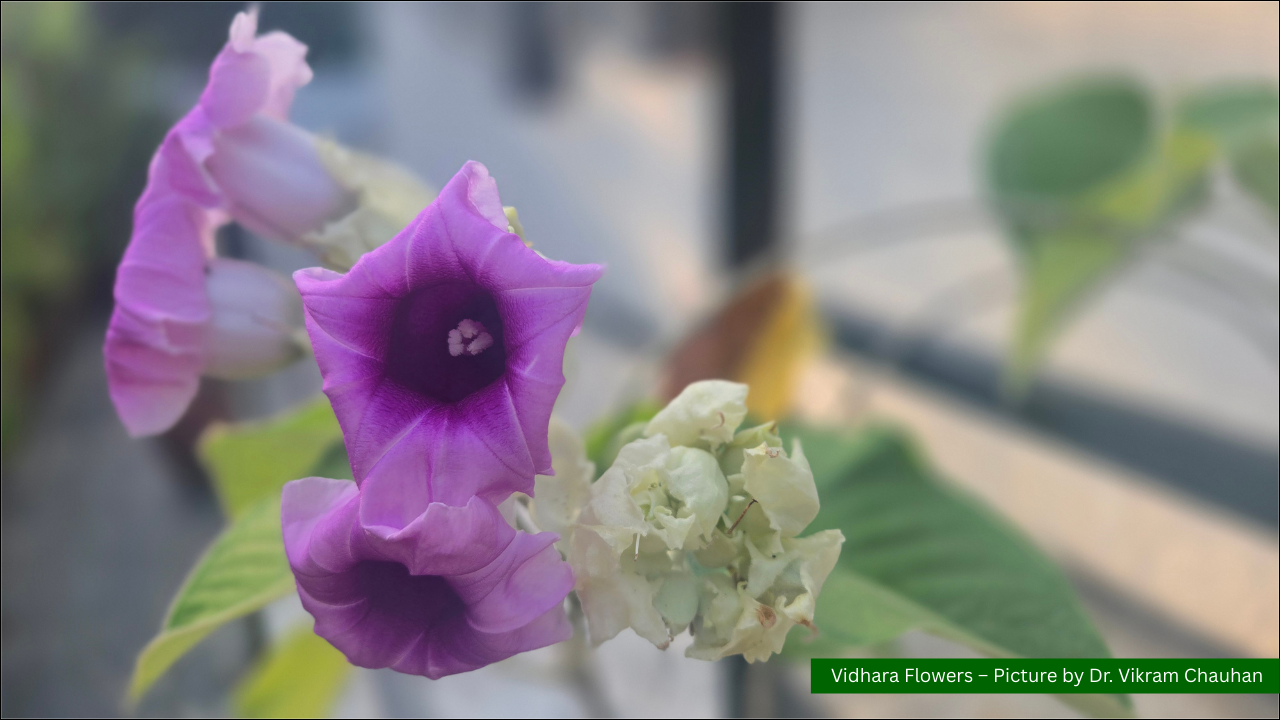
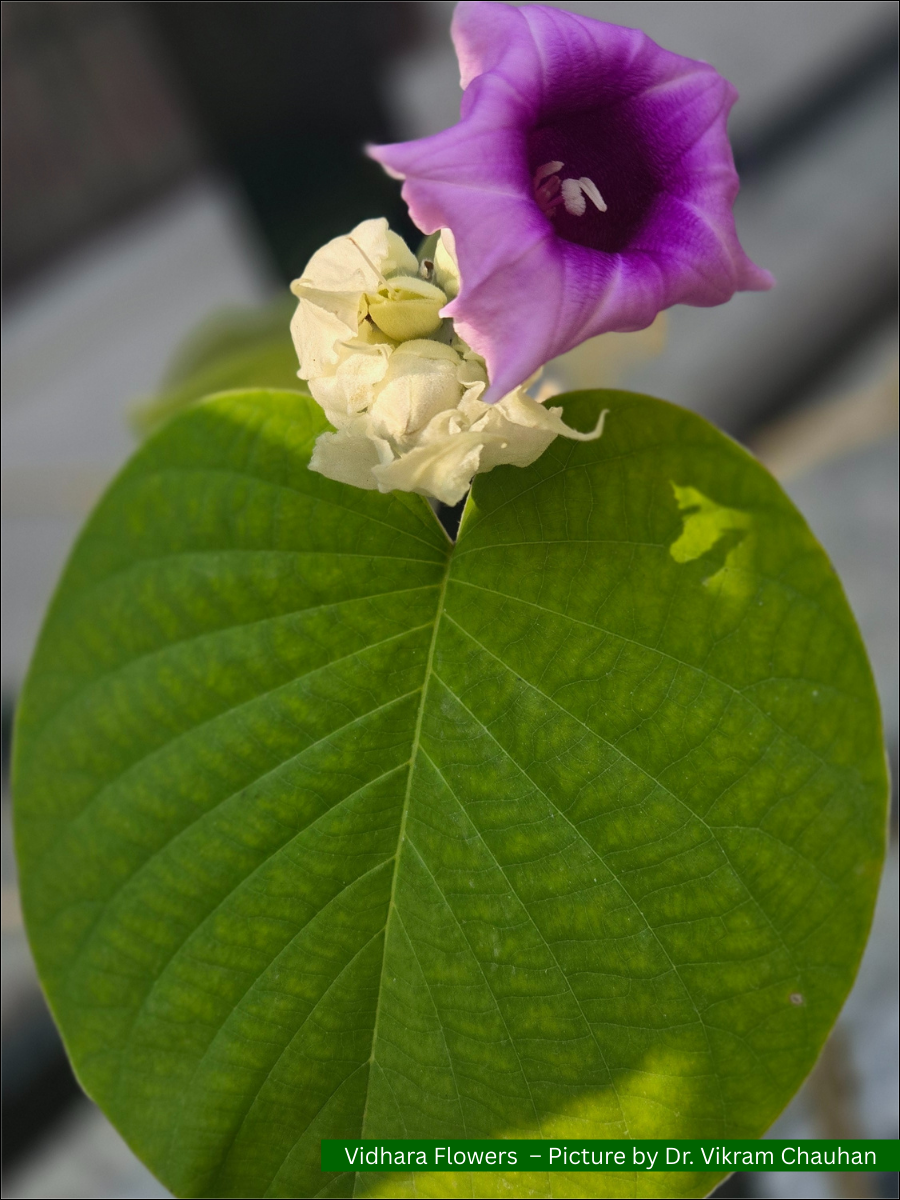
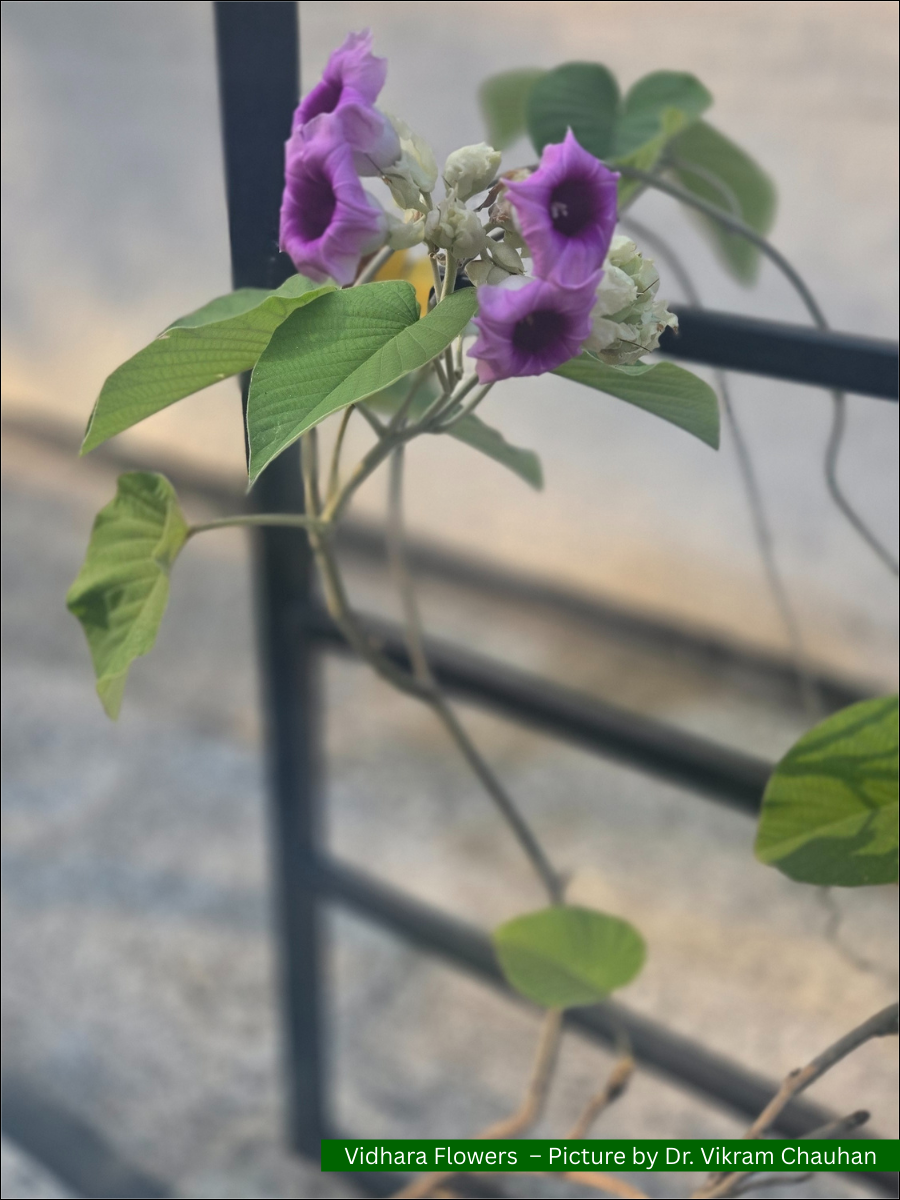
Vernacular Names
- English – Elephant Creeper, Hawaiian Baby Woodrose, Baby Wood-rose, Elephant-climber, Silver Morning Glory, Woolly Morning Glory, Elephant-vine, Wood-rose
- Sanskrit – Vriddhadaru, Vriddha Daraka
- Hindi – Samudra Shokha, Vidhara
- Bengali – Bijraka, Abegi, Bijataraka
- Gujarati – Samudrasokh, Samudrasoka
- Marathi – Samudrasoka, Varadhara, Gugguli
- Tamil – Kadal Palai, Samudrappachai, Samuttira-p-palai, Samuddirapachai
- Telugu – Chandrapada, Samudra Pala, Chandra Pala
- Kannada – Chandrapada, Samudrahaal
- Malayalam – Samudra-pachcha, Maruthudari
- Odia – Byrdhottareko, Munda Nai, Bastantri
- Tulu – Kadasige
- Konkani – Samudra-sok
- Assamese – Bisadharaka Lata, Hemlata
- Unani – Samudra Sokh
- Nepali – Samudra Phool
- Sinhalese – Vriddhadaru
Habitat
Argyreia nervosa is native to the Indian subcontinent, where it commonly grows in forest margins, jungle thickets, and moist ravines. It flourishes particularly in tropical and subtropical climates, adapting well to both wet tropical regions and seasonal monsoonal environments. The vine exhibits high tolerance to varied soil types, thriving best in moderately fertile, well-drained soils, yet capable of surviving under less favourable conditions. As a vigorous climbing liana, it uses surrounding vegetation for structural support, enabling it to rapidly ascend toward sunlight even when young plants can tolerate partial shade. Due to its hardiness, fast growth, and opportunistic climbing habit, the species has spread beyond its native range. In many introduced regions, such as Hawaii, Australia, and the Caribbean, it has become an invasive environmental weed, aggressively colonising both disturbed lands and intact forest ecosystems by smothering native vegetation and competing for essential resources.
Morphology
Argyreia nervosa is a large, twining climber that spreads extensively over supporting trees. The young branches are covered with a dense, whitish, silky tomentum. Leaves are broadly ovate to heart-shaped, measuring about 15–30 cm in width, with a rounded or occasionally pointed apex. The upper surface is smooth and green, whereas the lower surface is characteristically white and velvety due to dense hairs. Each leaf is borne on a petiole measuring 7.5–22 cm in length. The flowers are bell-shaped, approximately 5–7.5 cm long, externally whitish and pubescent, and internally deep pink to purple. The fruits are ellipsoid, about 12 mm in diameter, greenish when unripe and turning yellowish-brown upon maturation. Seeds are whitish with a brown tinge, possessing three distinct ridges. In Ayurvedic practice, the stem pieces and root of this plant are primarily used under the name Vidhara. Additionally, leaves and tender roots are also utilised for certain medicinal preparations.
Controversy
Some authors identify Ipomoea biloba Forsk., Ipomoea petaloidea Chois., and related species as Vriddhadaru. Since these plants exhibit similar therapeutic properties, they may be used interchangeably in medicinal practice when the authentic drug is not available.
Classical Categorisation
- According to Charaka Samhita – Sukrajanana
- According to Sushruta Samhita – Adhobhagahara
- According to Dhanvantari Nighantu – Karviradi Varga
- According to Bhavaprakash Nighantu – Guducyadi Varga
- According to Raj Nighantu – Guducyadi Varga
- According to Nighantu Adarsha – Vriddhadarukadi Varga
Ancient Verses
वृद्धदारुक आवेगी छागान्त्री वृष्यगन्धिका ।
वृद्धद्वारुः कषायोष्णः कटुस्तिक्तो रसायनः ॥
वृष्यो वातामवातार्शः शोथमेहकफप्रणुत् ।
शुक्रायुर्बलमेधाऽग्निस्वरकान्तिकरः सरः ॥
(Bhavprakash Nighantu Guduchyadi varga)
According to the above Shloka, the names of Vidhara include Vriddhadaruk, Avegi, Chhagantree, and Vrishyagandhika. Vidhara possesses astringent, pungent, and bitter tastes. It acts as a rejuvenative (Rasayana) and aphrodisiac (Vrishya) herb. It is strength-promoting, warm in potency (Ushna Veerya), and enhances semen, longevity, physical strength, intellect, digestive fire, voice, and complexion. Additionally, it helps alleviate Vata, Amavata (rheumatic disorders), piles (Arsha), inflammation (Shotha), urinary disorders (Prameha), and Kapha-related conditions.
वृद्धदारुद्वयं गौल्यं पिच्छिलं कफवातहत् ।
बल्यं कासामदोषानं द्वितीयं स्वल्पवीर्य्यदम् ।।
(Raj Nighantu Guduchyadi varga 119)
According to the above shloka, both varieties of Vriddhadaruka are sweet in taste and possess a slimy nature. They help alleviate disorders caused by aggravated Kapha and Vata doshas, promote physical strength, and are beneficial in conditions like cough and Ama dosha (metabolic toxins due to poor digestion). However, the second variety is considered comparatively less potent.
Ayurvedic Properties
- Rasa (Taste) Katu (Pungent), Tikta (Bitter), Kashaya (Astringent)
- Veerya (Potency) Ushna (Hot)
- Karma (Therapeutic Actions) Kaphavata Shamaka (Pacifies Kapha and Vata)
Therapeutic Properties
- Aphrodisiac
- Rejuvenation
- Nervine tonic
- Diuretic
- Antirheumatic
- Hypotensive
- Spasmolytic
- Useful for skin problems
- Improve voice and complexion
- Antidiabetic
- Antiinflammatory
- Effective in piles
Systemic Actions
External Use
- Useful in wound cleansing and healing. For wound healing, the underside of the leaves is tied over the affected area to promote recovery.
Internal Administration
- Nervous System – Acts as a nerve tonic and intellect enhancer; beneficial in neuromuscular disorders.
- Digestive System – Works as a carminative and detoxifier, helps in the proper movement of doshas, and acts as a mild purgative. Indicated in loss of appetite, constipation, haemorrhoids, and Ama dosha.
- Respiratory System – Useful in cough and hoarseness of voice.
- Circulatory System – Serves as a cardiac tonic; indicated in conditions like oedema.
- Reproductive System – Acts as an aphrodisiac; beneficial in inflammatory conditions of the female reproductive system and in leukorrhea.
- Excretory System – Helpful in managing diabetes.
- Satmikarana (Rejuvenation) – Functions as a rejuvenative; indicated in general debility and physical weakness.
Chemical Composition
1. Ergoline Alkaloids
Ergoline alkaloids (0.5–0.9%) (Contain chanoclavine, ergine, ergonovine, isoergine, lysergol, and lysergic acid.) – Possess psychoactive and vasoconstrictive properties; influence the central nervous system.
2. Ergometrine And Ergometrinine
Ergometrine and Ergometrinine – Uterotonic agents; stimulate uterine muscles and control bleeding.
3. Lysergic Acid Derivatives
Lysergic acid-α-hydroxy ethyl amide & Iso-lysergic acid-α-hydroxy ethyl amide – Hallucinogenic and CNS stimulant effects.
4. Agroclavine, Chanoclavine-I & II, Elymoclavine, Festuclavine
Act as CNS stimulants and may affect neurotransmission.
5. Lysergol And Related Alkaloids
Lysergol, Isolysergol, Molliclavine, Penniclavine, Setoclavine, Iso-setoclavine – Exhibit vasoconstrictor and psychotropic properties.
6. Ergine And Isoergine
Ergine (Lysergamide or LSA) and Isoergine – Main psychoactive compounds responsible for hallucinogenic and sedative effects.
7. Caffeic Acid And Ethyl Caffeate
Caffeic acid and Ethyl caffeate – Possess antioxidant, anti-inflammatory, and hepatoprotective properties.
8. Proteins And Amino Acids
Proteins and Amino acids (Lysine, Lutein) – Nutritional components that promote tissue repair and cellular health.
9. Argyroside
Argyroside (Steroidal glycoside) – Exhibits adaptogenic and tonic effects, enhancing vitality and strength.
10. Fatty Acids
Fatty acids (Palmitic, Oleic, Stearic, Behenic, Linoleic, Linolenic acids) – Support lipid metabolism and provide energy; oleic and linoleic acids are beneficial for cardiovascular health.
11. Triacontanol
Triacontanol (C30 alcohol) – Acts as a plant growth stimulant and may have lipid-lowering effects.
12. Methyl Esters
Methyl esters (Methyl myristate, Methyl palmitate, Methyl linoleate, Methyl oleate, etc.) – Contribute to antioxidant and emollient properties.
13. Lauric, Myristic, And Arachidic Acids
Lauric, Myristic, and Arachidic acids – Exhibit antimicrobial and moisturising actions.
14. Tetradecanyl Palmitate
Tetradecanyl palmitate – Provides emollient and protective action to tissues.
15. 5,8-Oxidotetracosan-10-one
5,8-Oxidotetracosan-10-one (Tetrahydrofuran derivative) – Reported to have antioxidant and anti-inflammatory properties.
16. Hexadecanyl p-Hydroxy Cinnamate
Hexadecanyl p-hydroxy cinnamate – Demonstrates antioxidant and antimicrobial activity.
17. Stigmasteryl p-Hydroxy Cinnamate
Stigmasteryl p-hydroxy cinnamate – Acts as a cholesterol-lowering and anti-inflammatory compound.
18. Scopoletin
Scopoletin (Coumarin compound) – Known for its anti-inflammatory, hepatoprotective, and antioxidant actions.
19. Kaempferol Derivatives
Kaempferol 7-OMe-3-sulfate & Kaempferol derivatives – Exhibit strong antioxidant, anti-inflammatory, and anti-cancer effects.
20. 6-Methoxy Coumarin Glycoside
6-Methoxy coumarin-7-O-α-D-glucopyranoside – Displays mild sedative and antispasmodic actions.
21. β-Sitosterol
β-Sitosterol – Reduces cholesterol, boosts immunity, and exhibits anti-inflammatory properties.
22. Epi-Friedelinol And Its Acetate
Epi-friedelinol and its acetate – Possess wound-healing and anti-inflammatory activity.
23. Quercetin
Quercetin – A potent antioxidant that supports liver health and reduces oxidative stress.
24. Flavone Glycosides
Flavone glycosides (Kaempferol 3-O-L-rhamnopyranoside, etc.) – Exhibit anti-ageing, antioxidant, and cardio-protective functions.
Modern Overview
Anti-Rheumatic Activity
The anti-rheumatic and anti-inflammatory action of Argyreia nervosa works through a synergistic mechanism involving multiple bioactive compounds that target inflammatory pathways. Flavonoids like quercetin and kaempferol exert antioxidant effects, neutralising free radicals and reducing oxidative stress that triggers joint inflammation. They also inhibit the enzyme cyclooxygenase (COX), thereby lowering prostaglandin synthesis, which is responsible for pain and swelling. Alkaloids such as ergine and isoergine modulate immune responses, helping prevent autoimmune joint destruction seen in rheumatic disorders. Meanwhile, compounds like hexadecanyl p-hydroxycinnamate and scopoletin from the roots enhance the plant’s anti-inflammatory and antimicrobial potential, supporting joint health and tissue repair.
Anti-Diabetic Activity
The anti-diabetic mechanism of Argyreia nervosa works through multiple biochemical pathways that help regulate glucose metabolism and insulin function. Its flavonoids—notably rutin, quercetin, isoquercetin, vitexin, and myricetin—inhibit alpha-amylase and alpha-glucosidase enzymes, slowing down carbohydrate breakdown and thereby reducing postprandial glucose spikes. These compounds also enhance insulin receptor sensitivity by modulating key signalling proteins such as IRS-1, AKT, and GLUT-4, which improve glucose uptake by cells. Additionally, its strong antioxidant profile neutralises free radicals and prevents oxidative stress–induced pancreatic β-cell damage, while its anti-inflammatory properties help suppress chronic inflammation that worsens insulin resistance.
For Hemorrhoids
The management of piles (haemorrhoids) with Argyreia nervosa (Argyreia speciosa) is based on its ability to reduce local inflammation, pain, and venous congestion through its bioactive compounds. Flavonoids act as natural phlebotonics, improving venous tone, reducing capillary permeability, and enhancing microcirculation in rectal tissues, thereby preventing bleeding and swelling. Saponins and steroids work synergistically to relieve inflammation and promote mucosal healing, while triterpenoids assist in tissue regeneration and wound repair. Moreover, alkaloids like ergine and isoergine exhibit analgesic and anti-inflammatory actions that help alleviate pain and irritation associated with piles. Together, these components support the plant’s traditional Ayurvedic role in soothing anorectal inflammation and strengthening blood vessels, leading to faster recovery and comfort.
Aphrodisiac Activity
The aphrodisiac action of Argyreia nervosa (Argyreia speciosa) is primarily attributed to its rich content of ergoline alkaloids, particularly ergine, isoergine, and lysergic acid amide (LSA), which influence the neuroendocrine system. These alkaloids are known to stimulate the hypothalamic–pituitary–gonadal axis, enhancing the release of gonadotropins and increasing testosterone synthesis, which in turn improves libido, sexual vigor, and performance. The N-methyl ergometrine component found in the roots may act on dopaminergic receptors, enhancing sexual motivation and erectile response. Additionally, the plant’s antioxidant and adaptogenic properties improve overall vitality and reduce stress-induced sexual dysfunction, promoting reproductive health naturally.
Brain Tonic Activity
The nootropic (brain tonic) activity of Argyreia nervosa (Argyreia speciosa) arises from the synergistic action of its ergoline alkaloids, flavonoids, phenolic compounds, and coumarin derivatives that work together to enhance brain function and protect neural integrity. The ergoline alkaloids (ergine, isoergine, ergometrine) modulate neurotransmitters such as serotonin and dopamine, which help regulate mood, memory, and cognitive alertness. Flavonoids like quercetin and kaempferol act as strong antioxidants, shielding neurons from oxidative stress and inflammation that contribute to cognitive decline. Phenolic compounds further enhance this neuroprotection, while scopoletin, a coumarin derivative, inhibits acetylcholinesterase — increasing acetylcholine levels and improving learning and memory. Collectively, these phytoconstituents nourish the nervous system, balance neurochemistry, and support long-term cognitive health.
Practical Uses
- Headache and Pedal Edema: A fine paste of mature green leaves (with tamarind leaves optionally) is warmed slightly and applied to the forehead to relieve acute headache. The same paste applied to the forelegs and feet helps reduce pedal edema (swelling).
- Emaciation and Loss of Libido: Medicated milk prepared from the roots is traditionally consumed in West Bengal and Kerala to enhance sexual vigour, improve body strength, and promote muscle bulk. It acts as a natural rejuvenator like modern nutritional supplements.
- Arthritis and Joint Pain: A decoction made from 10–15 g of coarse root powder (boiled and reduced to half) is taken in doses of 30–40 ml twice daily. It effectively relieves acute and chronic pain, arthritis, and body aches. The paste of its leaves can be applied to joint swelling after warming it.
- Gynaecological Disorders: Equal parts of Vriddhadaru, Lodhra (Symplocos racemosa), and Ashoka (Saraca asoka) are powdered. About 5 g of this powder mixed with ghee and sugar candy is taken daily for a week to manage menorrhagia and leucorrhea.
- Its root is used for nutritional purposes in Bengal.
- Powder of Ashwagandha (Withania somnifera) and Vidhara (Argyreia nervosa / Argyreia speciosa) in equal amounts can be taken with milk at a dosage of 3gms.
- Slightly heated leaves of Argyreia speciosa are applied over pus-filled wounds to promote quick ripening and proper healing.
- Root powder (3–5 g) is administered to manage oligospermia and improve sperm count.
- A cold infusion or decoction of the plant (40–50 ml) helps in controlling diabetes.
- Root decoction is beneficial in conditions like leucorrhea and fever.
- Root powder taken with honey relieves cough and enhances voice quality.
- Seed powder (2–3 g) is useful in treating insomnia and promoting sound sleep.
- Decoction of Vriddhadaru (30–40 ml) strengthens the nerves and cardiac muscles.
- Leaf juice improves digestion, stimulates appetite, and relieves constipation.
- Ghee cooked with Vriddhadaru root, when taken with milk, acts as an excellent aphrodisiac and promotes fertility.
Part Used
- Roots
- Leaves
Dosage
- Root powder- 1.5-3 gms
Ayurveda Products with Vidhara /Argyreia nervosa (Burm. f.) / Argyreia speciosa Sweet./ Elephant creeper
- Laxmibilas Ras
- Maha Laxmi Vilas Ras
Planet Ayurveda Products with Vidhara /Argyreia nervosa (Burm. f.) / Argyreia speciosa Sweet./ Elephant creeper
Conclusion
Argyreia nervosa (syn. Argyreia speciosa), commonly known as Vidhara or Elephant Creeper, is a highly valued medicinal plant in Ayurveda known for its potent rejuvenative (Rasayana) and aphrodisiac (Vajikarana) properties. The plant is rich in diverse phytoconstituents such as alkaloids, flavonoids, and glycosides, which contribute to its therapeutic actions on the nervous, reproductive, and digestive systems. It is traditionally used to manage conditions like infertility, weakness, diabetes, and inflammatory disorders. Regular use of its root and leaves under proper Ayurvedic guidance enhances vitality, stamina, and overall well-being. Hence, Argyreia nervosa stands as a powerful herb that bridges ancient Ayurvedic wisdom with modern phytomedicine for promoting holistic health.
Frequently Asked Questions (FAQ’s)
1. What Are The Uses Of Argyreia Nervosa (syn. Argyreia speciosa)?
Argyreia nervosa is used to treat wounds, cough, diabetes, arthritis, infertility, and nerve weakness, and also acts as a natural rejuvenator and aphrodisiac.
2. What Are The Medicinal Uses Of Argyreia Nervosa (syn. Argyreia speciosa)?
Medicinally, it is used for managing diabetes, leucorrhea, insomnia, emaciation, joint pain, and male infertility, while also improving strength, vitality, and digestion.
3. Argyreia Nervosa Vs. Argyreia Speciosa?
Both names refer to the same plant species, known synonymously in botany; Argyreia nervosa and Argyreia speciosa are interchangeable names for Vriddhadaru.
4. Write About The Seeds Of Argyreia Nervosa (syn. Argyreia speciosa).
The seeds contain alkaloids like ergine and lysergic acid derivatives; they are used in small doses to relieve insomnia and enhance mental calmness.
5. What Is The Common Name Of Argyreia Nervosa?
The common name of Argyreia nervosa is Elephant Creeper or Vriddhadaru in Ayurveda.



